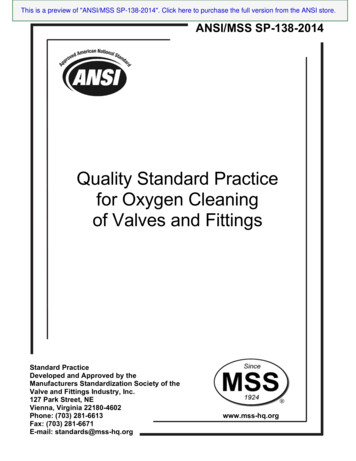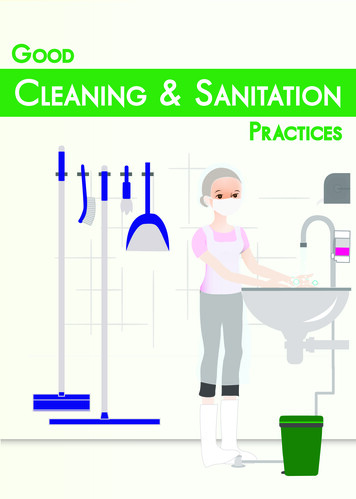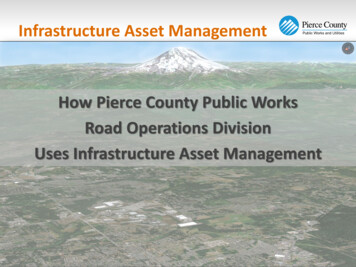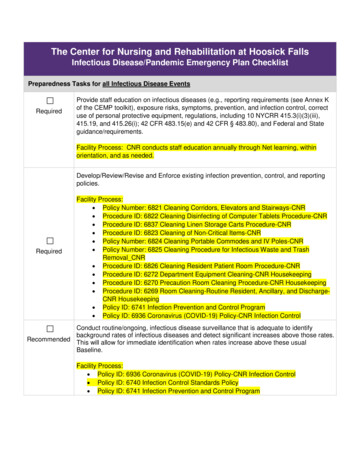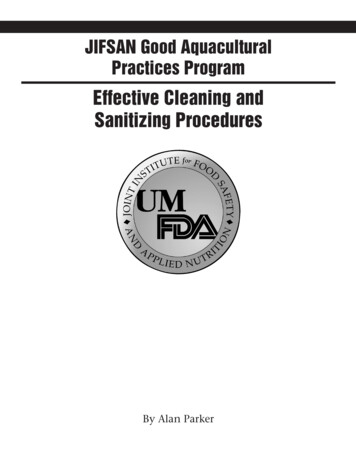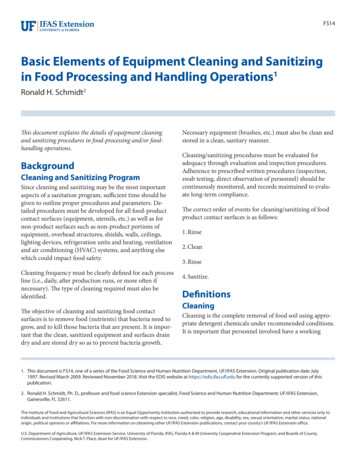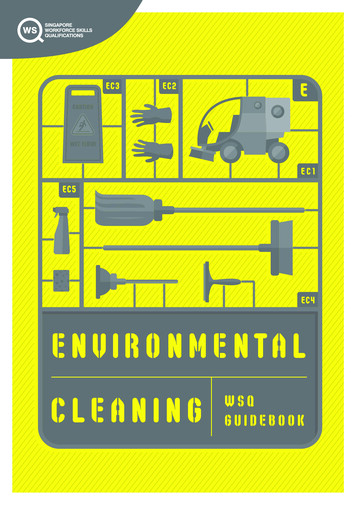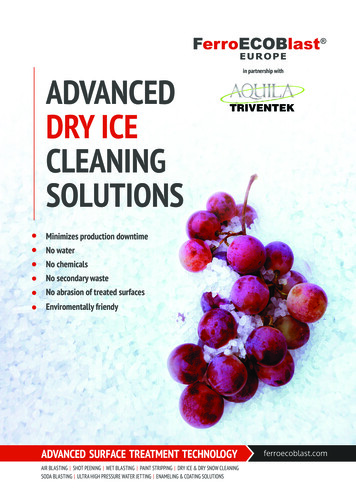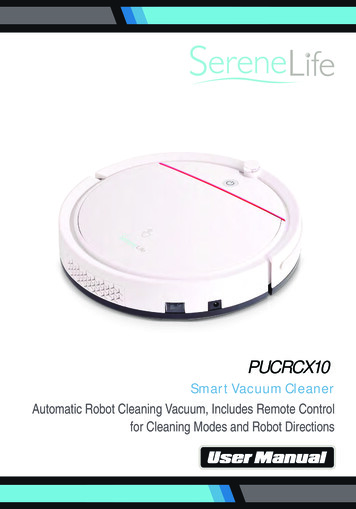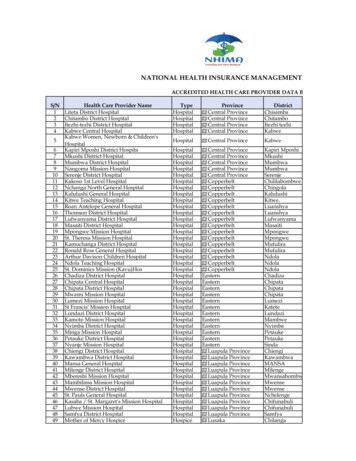
Transcription
National Cleaning Manual AppendicesNational Hospital Office –National Cleaning ManualAppendicesNational Cleaning Manual September 20061
National Cleaning Manual AppendicesIndexPage no.3.16.19.36.39.46.48.60.61.64.71.72.Appendix 1 – National Cleaning Element SpecificationsAppendix 2 – National Cleaning Audit Tool Information (Note: Excel document to accompany)Appendix 3 – Service Level Specification (Template), including Order of Work NotesAppendix 4 – National Risk CategoriesAppendix 5 – National Minimum Cleaning FrequenciesAppendix 6 – National Colour Coding SystemAppendix 7 – National Decontamination PolicyAppendix 8 - Categories of Healthcare WasteAppendix 9 – National Linen Segregation PolicyAppendix 10 – A-Z Decontamination of EquipmentAppendix 11 – Patient Equipment Cleaning Responsibility FormAppendix 12 - National Ward Kitchen PolicyNational Cleaning Manual September 20062
National Cleaning Manual AppendicesAppendix 1 - National Cleaning Element SpecificationsENVIRONMENTElement1. Overall appearance2. Odour controlSpecification·All areas should be clean, tidy and well-maintained, be free of rust, with noblood or body substances, dust, dirt, debris and spillages and beuncluttered with only appropriate, cleanable, well-maintained furniture,fixtures and fittings used.·Fire exit and entrance doors are clear and unhindered.·No inappropriate storage of goods or equipment in rooms and corridors·The environment and equipment should be clean and free from offensiveodours·Areas should be adequately ventilated with ventilation units cleaned andserviced accordingly·Any deodorisers (wall mounted) should be clean, functional and regularlychecked, the use of deodorisers and aerosols should be avoided wherepossiblePATIENT EQUIPMENT - Patient equipment - direct contactElementSpecification3. Commodes, weighing scales, manual handlingequipment·Direct contact patient equipment, including all component parts, should beclean and well-maintained with no blood or body substances, rust, dust,dirt, debris and spillages.4. Medical equipment including intravenousinfusion pumps drip stands and pulseoximeters NOT CONNECTED·Direct contact patient equipment, including all component parts, should beclean and well-maintained with no blood or body substances, rust, dust,dirt, debris and spillages.National Cleaning Manual September 20063
National Cleaning Manual Appendices5. Medical equipment including intravenousinfusion pumps drip stands and pulseoximeters CONNECTED·Direct contact patient equipment, including all component parts, should beclean and well-maintained with no blood or body substances, rust, dust,dirt, debris and spillages.6. Patient washbowls·Direct contact patient equipment, including all component parts, should beshould be clean and well-maintained with no blood or body substances,rust, dust, dirt, debris and spillages.·Patient washbowls should be decontaminated appropriately betweenpatients and should be stored clean, dry and inverted.·Badly scratched bowls should be replaced; stainless steel is preferable in theacute setting.7. Bedside oxygen and suction connectors,earpieces for radios (single use earpiecespreferable)·Direct contact patient equipment, including all component parts should beshould be clean and well-maintained with no blood or body substances,rust, dust, dirt, debris and spillages.8. Patient fans·Direct / Close contact patient equipment, including all component partsshould be should be clean and well-maintained with no blood or bodysubstances, rust, dust, dirt, debris and spillages.·Fans not recommended in clinical areas, if used a documented cleaningschedule to include ‘blades’ must be in place.National Cleaning Manual September 20064
National Cleaning Manual AppendicesPatient equipment – Close contactElement9. Bedside Alcohol Hand Gel/ Soap Containers/Dispensers /Brackets10. Chart trolley /Drugs trolley11. Patient personal items including cards,personal items, ornaments, etc.National Cleaning Manual September 2006Specification·Dispensers / hand-wash containers / brackets including all componentparts should be clean and well-maintained with no blood or bodysubstances, dust, dirt, debris and spillages, and available at appropriatelocations.·Hand-wash dispensers should be free of product build-up around thenozzle.·Containers should be replaced when empty; containers that facilitatetopping-up should not be used.·To avoid splashes on surfaces splash-backs should be provided.·Close contact patient equipment, including all component parts should beshould be clean and well-maintained with no blood or body substances,rust, dust, dirt, debris and spillages.·Patient personal items, including all component parts should be clean andwell-maintained with no blood or body substances, rust, dust, dirt, debrisand spillages.·Loose items, such as clothing, should be stored away either in the locker orproperty bag.·Flower vases where present should be clean with water changed minimumdaily.·Wilted flowers where present should be removed and disposed ofaccordingly. (Note: flowers not recommended in high risk areas)·Personal food items, including fruit should preferably be stored in anairtight container.5
National Cleaning Manual Appendices12. Linen trolleyBUILDING - External and internal featuresElement13. Entrance/Exit14. Stairs (internal and external)National Cleaning Manual September 2006·Close contact patient equipment, including all component parts should beshould be clean and well-maintained with no blood or body substances,rust, dust, dirt, debris and spillagesSpecification·All entrance/exit areas (including fire exits) including all component partsshould be clean and well-maintained with no blood or body substances,rust, dust, dirt, debris and spillages.·Entrance matting and mat well if present, should be clean and in goodrepair·Internal signage should be clean, updated, well maintained and laminatedto enable cleaning.·If there is a designated smoking area, it must comply with national andlocal policies accordingly, a cigarette bin should be available, and the floorarea should be free of cigarette ends, matches, etc.·Stairs, steps and lifts, internal and external, including all component parts,should be clean and well-maintained with no blood or body substances,rust, dust, dirt, debris and spillages.·External stairs and steps where appropriate should be salted during thewinter months.6
National Cleaning Manual Appendices15. External areasFixed AssetsElement·All external areas including grounds, gardens, footpaths, ramps and carparks should be clean and well-maintained.·Waste bins where available should be clean, in good repair and covered asappropriate.·Cigarette bins should be available in appropriate areas.·All signage should be clean, updated, well maintained and laminated toenable cleaning and should be secured accordingly with due regard forsurfaces.Specification16. Switches, sockets and data points·All wall fixtures such as switches, sockets or data points should be cleanand well-maintained with no blood or body substances, rust, dust, dirt,debris and spillages.17. Walls·All wall surfaces (including skirting) should be clean and well-maintainedwith no blood or body substances, rust, dust, dirt, debris and spillages.18. Ceiling·All ceiling surfaces/tiles should be clean and well-maintained with noblood or body substances, dust, dirt, debris and spillages.19. All doors·Doors including all component parts should be clean and well-maintainedwith no blood or body substances, rust, dust, dirt, debris and spillages.20. All internal glass and glazing, includingpartitions·All internal glass should be clean and well-maintained with no blood orbody substances, dust, dirt, debris and spillages.21. All external glass and glazing·All external glass should be clean and well-maintained with no blood orbody substances, dust, dirt, debris and spillages.National Cleaning Manual September 20067
National Cleaning Manual Appendices22. Mirrors·All mirrors should clean and well-maintained with no blood or bodysubstances, dust, dirt, debris and spillages.23. Bedside patient TV·TV’s/radio’s and controls, including all component parts should be cleanand well-maintained with no blood or body substances, rust, dust, dirt,debris and spillages.24. Radiators·Radiators including all component parts should be should be clean andwell-maintained with no blood or body substances, rust, dust, dirt, debrisand spillages.25. Ventilation grilles extract and inlets·Ventilation units, including all component parts, should be clean and wellmaintained with no blood or body substances, rust, dust, dirt, debris andspillages.(Note: Cleaning and Maintenance schedulesessential)Hard FloorsElementSpecification26. Floor – polished·The complete floor should be clean and well-maintained with no blood orbody substances, dust, dirt, debris and spillages.27. Floor – non slip·The complete floor should be clean and well-maintained with no blood orbody substances, dust, dirt, debris and spillages.Soft FloorsElement28. Soft Floor (carpet)National Cleaning Manual September 2006Specification·The complete floor should be clean and well-maintained with no blood orbody substances, dust, dirt, debris and spillages.·Carpet is not recommended in clinical areas.8
National Cleaning Manual AppendicesFIXTURES - Electrical fixtures and appliancesElementSpecification·Pest control devices should be clean and well-maintained with no blood orbody substances, rust, dust, dirt, debris and spillages.30. Electrical items e.g. overhead lights.·Electrical items, including all component parts should be should be cleanand well-maintained with no blood or body substances, rust, dust, dirt,debris and spillages.31. Cleaning equipment·Cleaning equipment including all component parts should be clean andwell-maintained with no blood or body substances, dust, dirt, debris andspillages, on risk assessment HEPA filters should be used in high risk areas,HEPA filters to be used in accordance with manufacturers’ instruction andlocal infection control recommendations29. Pest control devices(Note: Devices should not be handled or visible,service contracts to include standards required)Furnishings, fixtures and fittingsElementSpecifications32. High surfaces·All surfaces should be clean and well-maintained with no blood or bodysubstances, rust, dust, dirt, debris and spillages.33. Low surfaces·All surfaces should be clean and well-maintained with no blood or bodysubstances, rust, dust, dirt, debris and spillages.34. Chairs·All surfaces should be clean and well-maintained with no blood or bodysubstances, rust, dust, dirt, debris and spillages.35. Beds / Patient Couches / Trolleys / Mattresses·All surfaces should be clean and well-maintained with no blood or bodysubstances, rust, dust, dirt, debris and spillages.National Cleaning Manual September 20069
National Cleaning Manual Appendices36. Lockers /wardrobes/drawers·All surfaces should be clean and well-maintained with no blood or bodysubstances, rust, dust, dirt, debris and spillages.37. Tables / Bed tables·All surfaces should be clean and well-maintained with no blood or bodysubstances, rust, dust, dirt, debris and spillages.38. All dispensers and holders·Dispensers, holders, wall brackets including all component parts should beclean and well-maintained with no blood or body substances, dust, dirt,debris and spillages·Dispensers should be free of product build-up around the nozzle.·Containers should be replaced when empty; containers that facilitatetopping-up should not be used, to avoid splashes on surfaces splash-backsshould be provided.·The waste receptacle including all component parts should be clean andwell-maintained with no blood or body substances, rust, dust, dirt, debrisand spillages.·Bins should be emptied as appropriate, with fresh liners fitted inaccordance with local and national policy. Bags should be removed andlabelled/tagged when no more than ¾ full and stored appropriately in asecure location.·There should be an agreed schedule in operation for replacement of sanibins in place.·The sani-bin/nappy bin, including all component parts should be clean andwell-maintained with no blood or body substances, rust, dust, dirt, debrisand spillages.39. Waste receptacles, Sani-bins & Nappy Bins(Note: service contracts to include standardsrequired)National Cleaning Manual September 200610
National Cleaning Manual Appendices40. Curtains (window and cubicle) and blindsKitchen fixtures and appliancesElement41. Dishwasher/ microwave (kitchen use only)42. Fridge and/or freezerNational Cleaning Manual September 2006·Curtains, blinds, and associated fittings and attachments should be cleanand well-maintained, with no blood or body substances, rust, dust, dirt,debris and spillages.·A curtain and blinds cleaning schedule should be in place with recordsmaintained accordingly.·When curtains are changed after infected cases records should be kept.Specification·Dishwashers & all other appliances, including all component parts shouldbe clean, and well-maintained, with no blood or body substances, rust,dust, dirt, debris, stains, spillages and food debris.·Dishwashers should be emptied after each use.·The minimum temperature for the disinfecting cycle should be greater thanor equal to 82 degrees Celsius with temperature monitored accordingly.·The fridge and/or freezer should be clean and well-maintained with noblood or body substances, rust, dust, dirt, debris and spillages, with nobuild-up of ice.·There should be no storage of blood, medicines or laboratory specimens,kitchen/pantry fridges/freezers are strictly for use of storage of patientfoods as supplied and/or approved by hospital staff, food items shouldonly be stored in appropriate food contact materials.·Fridge temperatures should be less than or equal to 5 degrees Celsius,with at least daily monitoring accordingly.11
National Cleaning Manual Appendices·All food handling and ward kitchens must be compliant with food safetylegislation and standards IS 340 and 343·(Note: service contracts to include standardsrequired)Ice Machines/Boilers/Milk Dispensers/Water Dispensers/Fountains,including all component parts should be clean and well-maintained withno blood or body substances, rust, dust, dirt, debris and spillages.·If ice machines are in use they should be self-dispensing.44. Kitchen cupboards·Kitchen cupboards and shelving, including all component parts should beclean and well-maintained, with no blood or body substances, rust, dust,dirt, debris and spillages.45. Cleaning equipment catering·All cleaning equipment, including all component parts should be clean andwell-maintained with no blood or body substances, dust, dirt, debris andspillages and comply with colour coding policy43. Ice machine / hot water boiler/ drinking waterfountain / drinking water coolerToilets, sinks, hand-wash basins and bathroom fixturesElementSpecification - (Flushing frequencies to be agreed, all water outlets should beflushed appropriately and at a temperature of greater than or equal to 50degrees celsius, as per National Legionella guidelines )46. 47. & 48. Bathrooms/ Showers /Wash HandBasins.National Cleaning Manual September 2006·Bathrooms, Showers and Wash Hand Basins should be clean and wellmaintained with no blood or body substances, rust, dust, dirt, debris andspillages.·All bathroom fittings including component parts, and all associated fittings,e.g. tiles, taps, showerheads, dispensers, toilet brushes etc. should be cleanand well-maintained with no blood or body substances, rust, dust, dirt,debris and spillages, and polished accordingly12
National Cleaning Manual Appendices·Shower curtains if present should be clean and in good repair, with aschedule in place for laundering and replacement.·Only designated store rooms should be used for storage purposes.·Toilets, slop hoppers, bidets, urinals etc. should be clean and wellmaintained with no blood or body substances, rust, dust, dirt, debris andspillages.·All bathroom fittings including component parts, and all associated fittings,e.g. tiles, taps, showerheads, dispensers, toilet brushes etc. should be cleanand well-maintained with no blood or body substances, rust, dust, dirt,debris and spillages, and polished accordingly·Only designated store rooms should be used for storage purposes.51. Sanitary accommodation & Sanitary wareoverall appearance·All sanitary accommodation and sanitary ware should be clean and wellmaintained with no blood or body substances, rust, dust, dirt, debris andspillages.52. Replenishment of Consumables·Adequate and approved consumables such as liquid soap, paper towelsand toilet paper should be readily available and stored appropriately.·Appropriate dispensers should be available with dispensers and allcomponent parts clean and well-maintained accordingly.53. Computers / Telephones / Office Equipment·Telephones, computers, fax machines and associated office equipment,including all component parts should be clean and well-maintained withno blood or body substances, rust, dust, dirt, debris and spillages.54. Dirty Utility / Sluice room·Dirty utility and sluice rooms including all sanitary ware should be cleanand well-maintained with no blood or body substances, rust, dust, dirt,debris and spillages.49. & 50. Toilets / Urinals / Bidets / Slop Hoppers/ Sluices etc.National Cleaning Manual September 200613
National Cleaning Manual Appendices55. Cleaning Store / Cleaning Services Room /Cleaning CubbyNational Cleaning Manual September 2006·These areas must be kept clean and tidy at all times, be free from clutter,with no linen or waste build-up.·Hand washing facilities must be available.·All cleaning equipment including component parts should be clean andwell-maintained with no blood or body substances, rust, dust, dirt, debrisand spillages. All cleaning equipment should be cleaned daily inaccordance with cleaning specification and used in accordance with thecleaning manual and stored inverted and dry as appropriate·Equipment with water reservoirs should be stored empty and dry·All cleaning equipment and products should be of adequate supply and beapproved for use by Infection Control Personnel and/or appropriate expertgroups.·Storage facilities should be provided in each work area with adequateventilation, a hot and cold water supply, and sluice and hand-washfacilities.·Storage facilities should be adequate, clean and well maintained.·All cleaning products and consumables should be stored on shelves inlocked cupboards and all cleaning products and equipment should complywith colour coding policy.14
National Cleaning Manual AppendicesNational Cleaning Elements Specifications – Comments RecordWard / Departmental AreaRisk ClassificationAudited by ational Cleaning Manual September tion Reqd.Action Taken15
National Cleaning Manual AppendicesAppendix 2 - National Cleaning Audit Tool Information (to accompany the audit tool)1. IntroductionThe National Hospitals Office (NHO) has made hygiene a priority since its inception. To this end the first ever National Hygiene Auditwas conducted together with the development of a set of National Hygiene Services Standards for Acute Hospitals.In partnership with the Irish Health Services Accreditation Board (IHSAB), draft hygiene services standards were realigned foraccreditation purposes and the IHSAB will be rolling-out the standards later this year. The IHSAB will be assessing each hospital once ayear with a review visit within six months of the initial assessment.To assist hospitals in implementing the national hygiene standards and as recommended in the National Hygiene Audit Reportsupporting documentation is being developed by the national working group. A significant document is a multidisciplinary cleaningaudit tool which aims to ensure continuous internal local monitoring of standards in acute hospitals.2. ObjectivesThe aim of setting standards is to ensure that everyone can determine whether the hospital is sufficiently clean, this requires some formof measurement or audit of cleanliness.The main objectives of undertaking audits are for quality improvement purposes and the audit results should be made available torelevant staff as soon as possible after the audit has been completed, agreement must be reached on corrective action accordingly.National Cleaning Manual September 200616
National Cleaning Manual Appendices3. ResponsibilitiesInternal audit will be a continuous process as part of the monitoring of standards and / or management of a cleaning contract. Thefrequency of monitoring is dependent on the risk classification, findings should be prioritised accordingly, an area classified as highrisk e.g. theatre suites, should be audited more frequently than an area classified as low risk, e.g. office. In addition a problem in a highrisk area will need to be resolved immediately, whereas a timescale can be agreed for a low risk area.Internal audits may only address a small sample of the hospital each week and may be element based, e.g. Floors or based onfunctional areas, e.g. a number of rooms in several wards.In addition to regular internal audits it is essential to carry our more comprehensive internal audits on an agreed regular basis toprovide Hospital Management with an overall picture; this tool can be used for both types of internal audit. These audits should becarried out by a multidisciplinary team representing all key stakeholders.4. How to use the Audit Tool?1. A separate audit sheet should be used for each area2. There are 55 elements which apply to each area3. The auditor should score each element as listed as acceptable or unacceptable in accordance with the cleaning elementsspecifications, see comment sheet attached to the elements listing, acceptable is indicated by a score of 1 and unacceptable isindicated as a score of 04. Some of the elements may be deemed not applicable and as such should be excluded from the marking5. The audit will be evidence based, if an element is deemed unacceptable the auditor must make a comment as to why it is notacceptable and indicate the corrective action needed including a timeframe6. The auditor should also take the opportunity to record a comment where there are particularly good findings7. The scoring is subjective and the auditor should exercise some discretion in judging the acceptability of an element, i.e. one ortwo scuffmarks on a floor do not indicate the element to be unacceptable8. The physical condition must also be taken into account, it may not be possible to remove some stains from a wall that needspainting, however, poor standards of maintenance does not justify poor standards of cleanliness9. The total number of acceptable scores should be expressed as both a percentage of the total score available in that element10. An average score for the functional area can be reached by adding all the total element scores and dividing by the applicablenumber of elementsNational Cleaning Manual September 200617
National Cleaning Manual Appendices11. The audit should:· Clearly identify anything that impacts on “cleanability”, i.e. maintenance, infrastructural deficits etc.· Identify tidiness issues that impact on the capability to clean, i.e. items for disposal on back landings and corridors, clutter etc.· Identify anything on the standards that doesn’t come within the remit of cleaning services staff, identify who is responsible, andcharge them with being responsible for same· Document the gaps in the present standards with the national standards· Identify gaps that need to be addressed and include same in the annual cleaning services plan and use to inform the operationalcleaning plan for each area / unitProposed Audit Frequencies GuidanceThe following table seeks to outline the minimum audit requirements for internal audits.1234Risk CategoryVery High RiskHigh RiskModerate RiskLow RiskMinimum Audit RequirementMonthly3 monthly6 monthlyAnnuallyNational Cleaning Manual September 200618
National Cleaning Manual AppendicesAppendix 3 - National Hospitals Office - Service Level Specification(Template)1. Definitions1.1 Any reference to this Service Level Specification or SLA shall be a reference to this Cleaning Service Level Specification.1.2 In this Service Level Specification (SLA) the following words and phrases shall have the following meaning unless the contextotherwise requires:Access Times means times as set out Table 1– Access Times of this Service Level Specification during which the provider (be it acontract or in-house service) shall be required to undertake the Cleaning Service;Cleaning Services means the cleaning to be provided by in accordance with this Service Level Specification;Cleaning Staff means those persons engaged or employed to carry out the Cleaning Services; be they in-house or contract staffClinical Areas means those areas on the site used to deliver clinical care to patients where the need for high standards of hygiene isparamount on a day-to-day basis;Deep Cleaning means the periodic cleaning of wall and ceiling surfaces in laboratories, theatres, specialist areas, wards and kitchensexcluding the routine day to day cleaning of sanitary fittings and floors, and spot cleaning of walls and doors in such areas;Elements means items to be cleaned within the hospital as defined in Appendix A.Functional Areas as defined in Table 3: Functional Area Categorisation in Appendix B.Hygiene Services means any additional services to be provided in tandem with cleaning services, e.g. waste management servicesMaterials mean those products necessary for the provision of Cleaning Services;Non-Clinical Areas means all areas on site not included under the category of Clinical Areas;Provider means whoever provides the cleaning service, irrespective of whether the service is provided in-house or contracted inScheduled Times means those times specified by the hospital as being appropriate to ensure that specified quality standards andservice levels are achieved at all times;Service Standards means the standards set out at Appendix A.Waste Removal means the removal of all waste as detailed in the Service Level Specification for Waste ManagementNational Cleaning Manual September 200619
National Cleaning Manual Appendices2. Key ObjectivesThe Provider is required to achieve a high level of environmental cleanliness throughout the facilities on the site. The key objectives are:· Provide a cost efficient, quality driven Cleaning Service which achieves an optimum standard of cleaning for all buildings andareas of the hospital complex appropriate for their use; and is held in high regard by patients, staff and visitors alike;· Provide a standard of Service that helps to provide a positive image of the hospital and a level of cleanliness which provides aclinical and socially acceptable environment for patients, visitors and staff, 365 (6) days of the year, 24 hours per day.· Staff encouraged to develop quality routines and to identify opportunities to improve service delivery. Every member of staff toshare a common objective and subscribe to the process of change and quality improvement. The Provider must develop staffthrough training for the mutual benefit of both individuals and the hospitals and to develop staff relationships between thedifferent departments involved in the cleaning process.· Maintain a safe environment and safe working practices including the use of a recognised risk assessment/management systemto ensure that standards of comfort and cleanliness stay high, and that any reduction in the quality of Service is recognised andcorrected.3. Key CustomersThe key customers for this service are:(a) Patients;(b) Infection Prevention and Control Teams;(c) Staff;(d) Visitors;(e) Service Providers.4. Process4.1 Scope4.1.1 The Provider shall comply with all requirements set out in the General Service Specification relevant to the delivery of theCleaning Services.4.1.2 In addition to the applicable provisions set in the General Service Specification, the Provider shall comply with the ServiceStandards and Service Requirements of this Service Specific Specification.National Cleaning Manual September 200620
National Cleaning Manual Appendices4.1.3 The Provider shall provide the Cleaning and Hygiene Service 24 hours per day 365(6) days per year on a scheduled and reactivebasis as maybe required to meet the Service Standards of this Service Level Specification described in Appendix A of this Service LevelSpecification.4.1.4 This Service Level Specification consists of two main sub-Services:a) Cleaning Service including:i) Scheduled and Reactive cleaning;ii) Planned Cleaning;iii) Barrier Cleaning;b) Hygiene Services including:i) Waste management;ii) Accommodation services; (and any other as specified by the hospital)4.1.5 The Provider shall be responsible for the cleaning of all functional areas, as defined in this Service Level Specification including:a) Very High Risk;b) High Risk Areas;c) Moderate Risk;d) Low Risk;4.1.6 Within each of these areas, the Provider shall be responsible for cleaning to agreed standards the following elements, except wherespecifically excluded by the hospital:a) All internal and external glass surfaces; (to what height)b) All floors, walls, and ceilings including skirtings and architrave’s, pipes and ducting; (including lifts and stairways)c) All sanitary ware, including replenishments of consumables;d) All furniture, fixtures and fittings, including doors, except where specifically excluded;e) All external features, fire exits stairwells, and entrance and exits;f) Patient equipment, except where specifically excluded;g) Electrical fixtures and appliances, except medical equipment;h) All soft furnishingsi) Kitchen/pantry; fixtures, fittings and appliances; int
National Cleaning Manual Appendices National Cleaning Manual September 2006 4 5. Medical equipment including intravenous infusion pumps drip stands and pulse oximeters CONNECTED · Direct contact patient equipment, including all component parts, should be clean and well-maintained with no blood or body substances, rust, dust, dirt, debris and .

